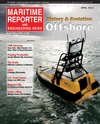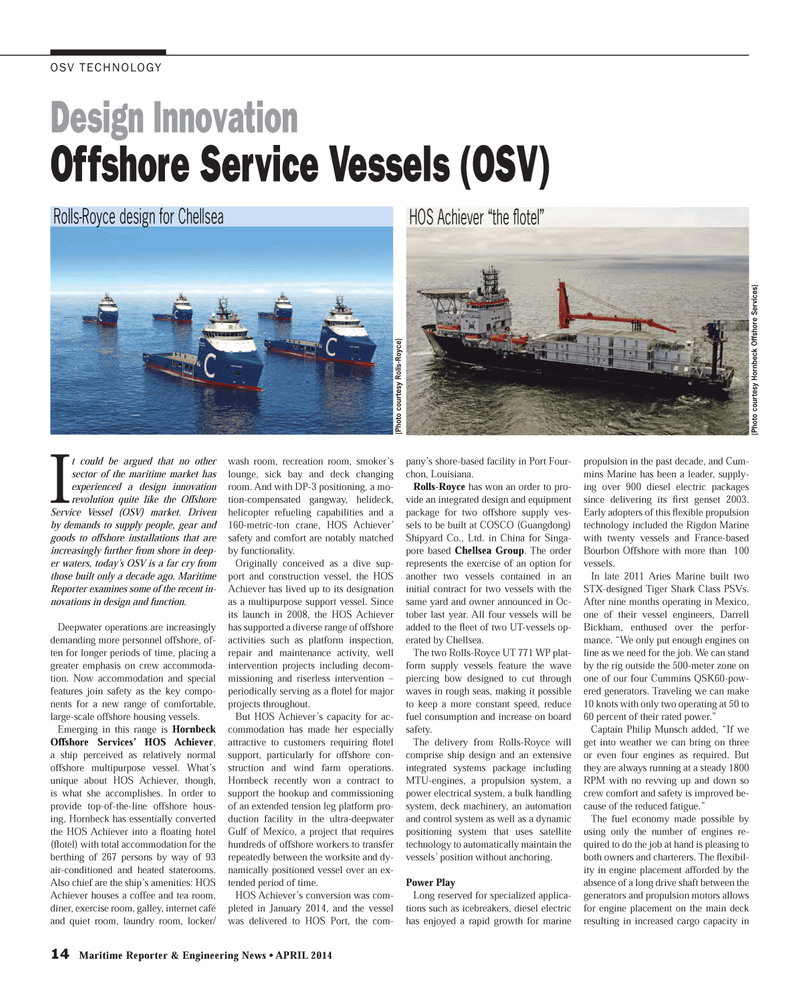
Page 14: of Maritime Reporter Magazine (April 2014)
Offshore Edition
Read this page in Pdf, Flash or Html5 edition of April 2014 Maritime Reporter Magazine
14 Maritime Reporter & Engineering News ? APRIL 2014 OSV TECHNOLOGY It could be argued that no other sector of the maritime market has experienced a design innovation revolution quite like the Offshore Service Vessel (OSV) market. Driven by demands to supply people, gear and goods to offshore installations that are increasingly further from shore in deep- er waters, today?s OSV is a far cry from those built only a decade ago. Maritime Reporter examines some of the recent in- novations in design and function.Deepwater operations are increasingly demanding more personnel offshore, of- ten for longer periods of time, placing a greater emphasis on crew accommoda-tion. Now accommodation and special features join safety as the key compo-nents for a new range of comfortable, large-scale offshore housing vessels. Emerging in this range is Hornbeck Offshore Services? HOS Achiever , a ship perceived as relatively normal offshore multipurpose vessel. What?s unique about HOS Achiever, though, is what she accomplishes. In order to provide top-of-the-line offshore hous- ing, Hornbeck has essentially converted the HOS Achiever into a ß oating hotel (ß otel) with total accommodation for the berthing of 267 persons by way of 93 air-conditioned and heated staterooms. Also chief are the ship?s amenities: HOS Achiever houses a coffee and tea room, diner, exercise room, galley, internet café and quiet room, laundry room, locker/wash room, recreation room, smoker?s lounge, sick bay and deck changing room. And with DP-3 positioning, a mo- tion-compensated gangway, helideck, helicopter refueling capabilities and a 160-metric-ton crane, HOS Achiever? safety and comfort are notably matched by functionality. Originally conceived as a dive sup-port and construction vessel, the HOS Achiever has lived up to its designation as a multipurpose support vessel. Since its launch in 2008, the HOS Achiever has supported a diverse range of offshore activities such as platform inspection, repair and maintenance activity, well intervention projects including decom-missioning and riserless intervention ? periodically serving as a ß otel for major projects throughout.But HOS Achiever?s capacity for ac- commodation has made her especially attractive to customers requiring ß otel support, particularly for offshore con- struction and wind farm operations. Hornbeck recently won a contract to support the hookup and commissioning of an extended tension leg platform pro-duction facility in the ultra-deepwater Gulf of Mexico, a project that requires hundreds of offshore workers to transfer repeatedly between the worksite and dy-namically positioned vessel over an ex-tended period of time.HOS Achiever?s conversion was com- pleted in January 2014, and the vessel was delivered to HOS Port, the com-pany?s shore-based facility in Port Four- chon, Louisiana.Rolls-Royce has won an order to pro-vide an integrated design and equipment package for two offshore supply ves- sels to be built at COSCO (Guangdong) Shipyard Co., Ltd. in China for Singa-pore based Chellsea Group . The order represents the exercise of an option for another two vessels contained in an initial contract for two vessels with the same yard and owner announced in Oc-tober last year. All four vessels will be added to the ß eet of two UT-vessels op- erated by Chellsea.The two Rolls-Royce UT 771 WP plat- form supply vessels feature the wave piercing bow designed to cut through waves in rough seas, making it possible to keep a more constant speed, reduce fuel consumption and increase on board safety. The delivery from Rolls-Royce will comprise ship design and an extensive integrated systems package including MTU-engines, a propulsion system, a power electrical system, a bulk handling system, deck machinery, an automation and control system as well as a dynamic positioning system that uses satellite technology to automatically maintain the vessels? position without anchoring. Power Play Long reserved for specialized applica-tions such as icebreakers, diesel electric has enjoyed a rapid growth for marine propulsion in the past decade, and Cum-mins Marine has been a leader, supply- ing over 900 diesel electric packages since delivering its Þ rst genset 2003. Early adopters of this ß exible propulsion technology included the Rigdon Marine with twenty vessels and France-based Bourbon Offshore with more than 100 vessels.In late 2011 Aries Marine built two STX-designed Tiger Shark Class PSVs. After nine months operating in Mexico, one of their vessel engineers, Darrell Bickham, enthused over the perfor- mance. ?We only put enough engines on line as we need for the job. We can stand by the rig outside the 500-meter zone on one of our four Cummins QSK60-pow-ered generators. Traveling we can make 10 knots with only two operating at 50 to 60 percent of their rated power.? Captain Philip Munsch added, ?If we get into weather we can bring on three or even four engines as required. But they are always running at a steady 1800 RPM with no revving up and down so crew comfort and safety is improved be-cause of the reduced fatigue.?The fuel economy made possible by using only the number of engines re-quired to do the job at hand is pleasing to both owners and charterers. The ß exibil-ity in engine placement afforded by the absence of a long drive shaft between the generators and propulsion motors allows for engine placement on the main deck resulting in increased cargo capacity in Design Innovation Offshore Service Vessels (OSV) (Photo courtesy Hornbeck Offshore Services) HOS Achiever ?the otel? (Photo courtesy Rolls-Royce) Rolls-Royce design for ChellseaMR #4 (10-17).indd 14MR #4 (10-17).indd 144/5/2014 3:15:37 PM4/5/2014 3:15:37 PM

 13
13

 15
15
